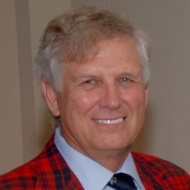An internationally recognized authority on golf course environmental issues, Dr. Michael Hurdzan, an American Society of  Golf Course Architects past president, studied turf management at Ohio State University and earned a masters degree and a Ph.D. in environmental plant physiology at the University of Vermont. His course portfolio includes Devil’s Pulpit Golf Course, and Devil’s Paintbrush Golf Course in Caledon, Ontario, Canada; Willowbend Country Club in Cape Cod, Massachusetts; River Course at Keystone in Keystone, Colorado; Bully Pulpit in Medora, North Dakota; Erin Hills in Hartford, Wisconsin; and Desert Willow in Palm Desert, California.
Golf Course Architects past president, studied turf management at Ohio State University and earned a masters degree and a Ph.D. in environmental plant physiology at the University of Vermont. His course portfolio includes Devil’s Pulpit Golf Course, and Devil’s Paintbrush Golf Course in Caledon, Ontario, Canada; Willowbend Country Club in Cape Cod, Massachusetts; River Course at Keystone in Keystone, Colorado; Bully Pulpit in Medora, North Dakota; Erin Hills in Hartford, Wisconsin; and Desert Willow in Palm Desert, California.
I’ve been involved with golf architecture for over forty years, and one of my fondest memories is sitting on a golf course construction site in the early 1970s, eating lunch with my mentor and partner, Jack Kidwell.
In those days Jack and I would lay out centerlines of golf holes, and we would grade-stake every single tee, green, bunker, pond, waterway, and the entire irrigation and drainage system. I don’t know any golf course architect who still does that, as it takes a lot of time and can be very hard work in tough terrain, but it did keep us in shape.
At that time I was a young captain in the United States Army Special Forces Reserve. I was always nosing around for Army surplus, and I found someone selling cases of C Rations. Combat Rations, or “C Rats,” as GI’s fondly called them, were introduced prior to World War II and persisted through the Vietnam War era. They came in a small brown box that contained a complete meal with a nutritional value of about 1,200 calories. C Rations included a canned entrée the GI’s usually called “mystery meat,” another can of crackers, cheese or peanut butter, dessert, and a syrupy fruit such as peaches or fruit cocktail. Everything a hungry soldier, or golf course architect, could hope for.
Jack and I would each take a C Rat and a canteen of water when we went to work on a golf course site. I remember sitting back on a grassy knoll, big rock, or log, eating our lunch and talking. It was a bonding experience like none other, and perhaps the main reason why we enjoyed such a close relationship for nearly fifty years. I was the son he never had.
By the late 1980s, Parkinson’s disease and cancer began to rob Jack of his mobility, but not of his mind, and his memory was sharp up until he died in 2001. During his last years he was confined to a wheelchair. Inevitably when we would sit and talk, Jack would bring up the subject of how much he enjoyed and missed our C Ration lunches together, and it seemed to make his day a little brighter.
